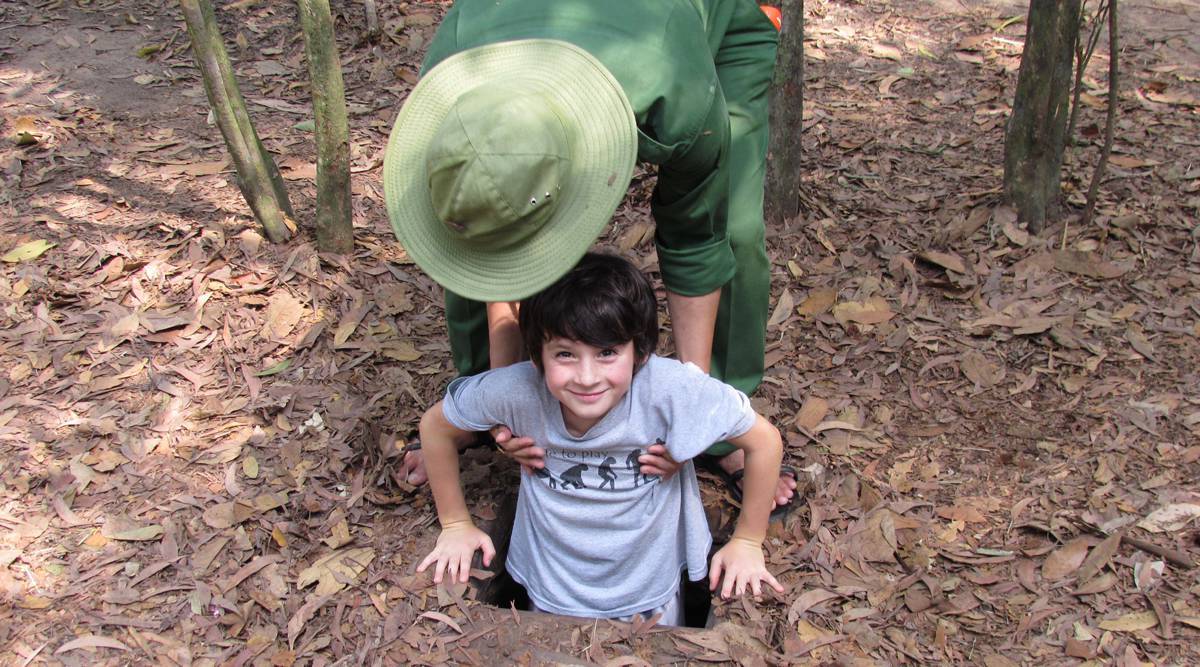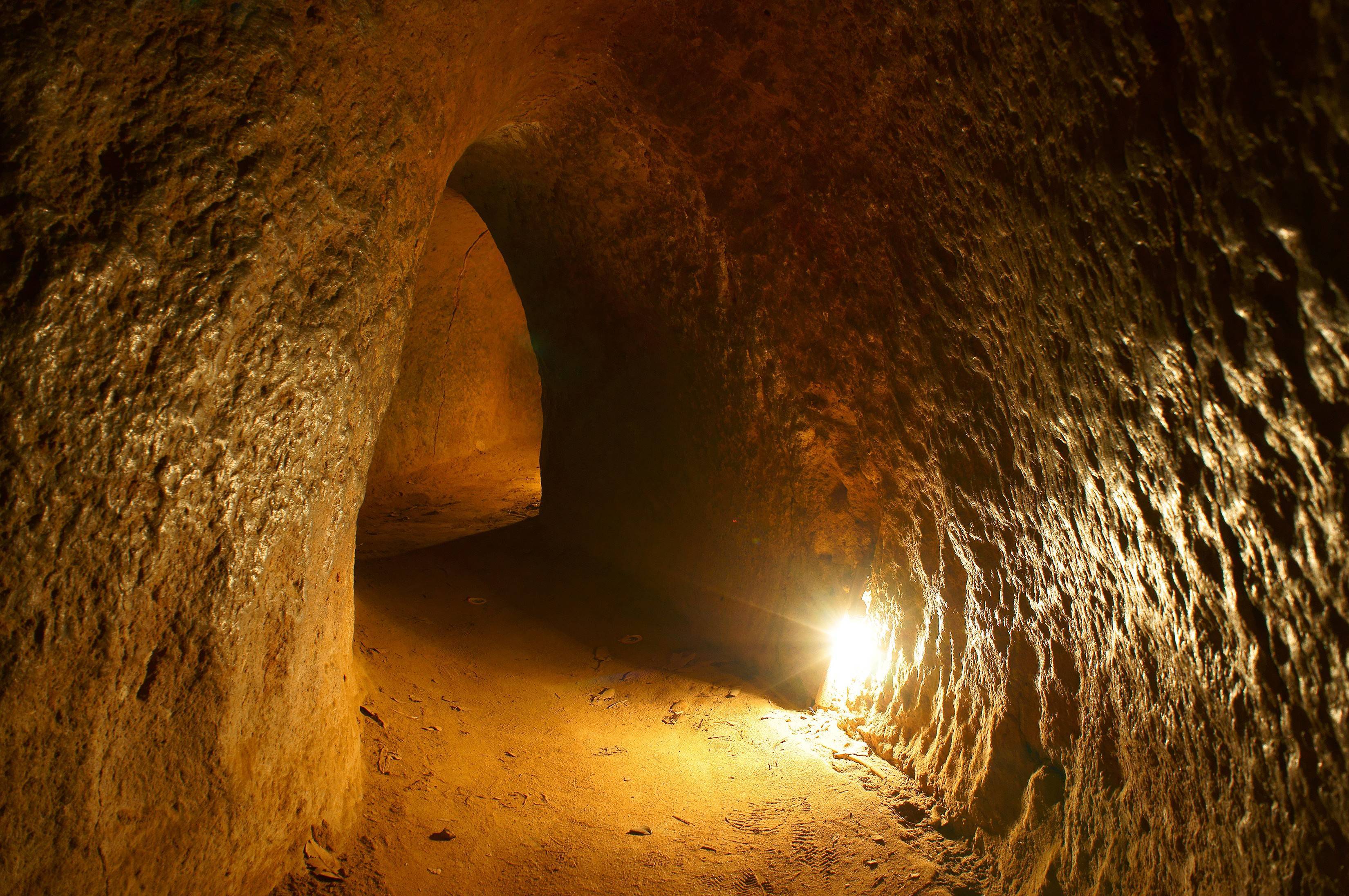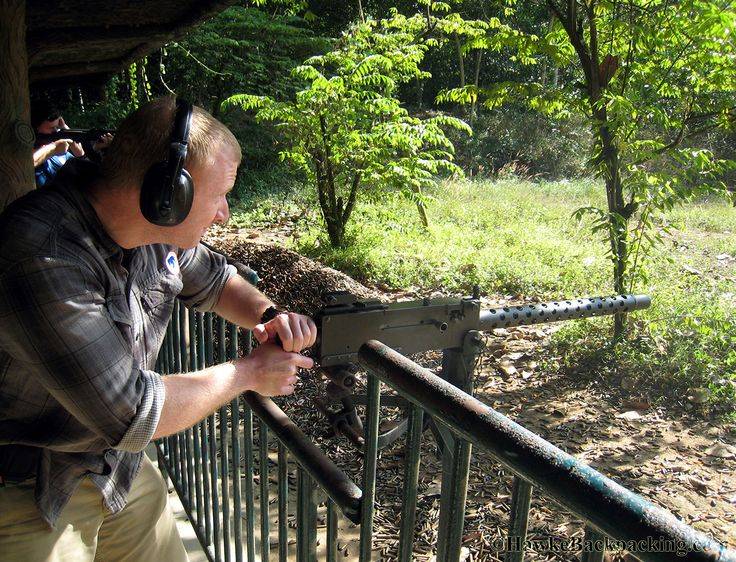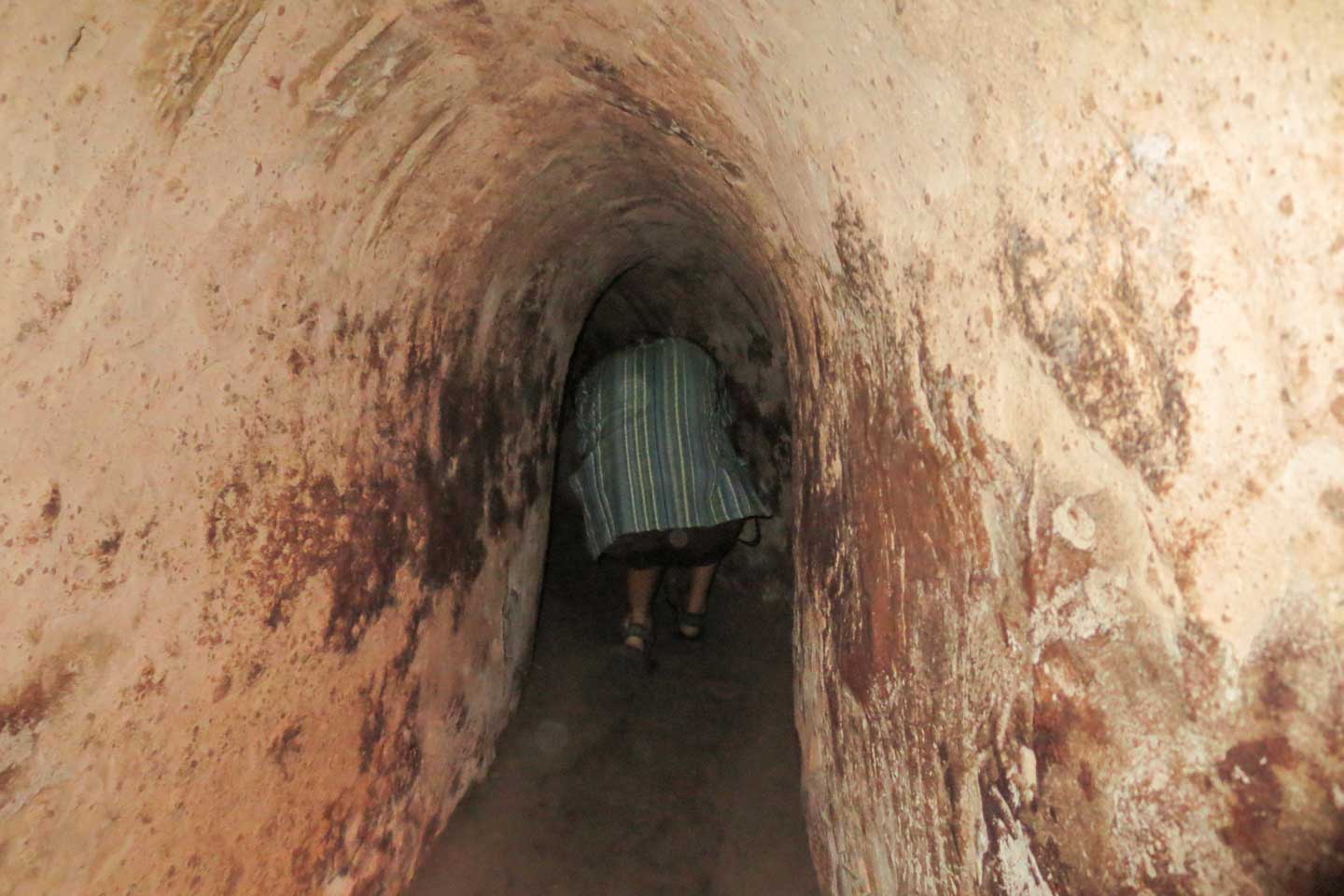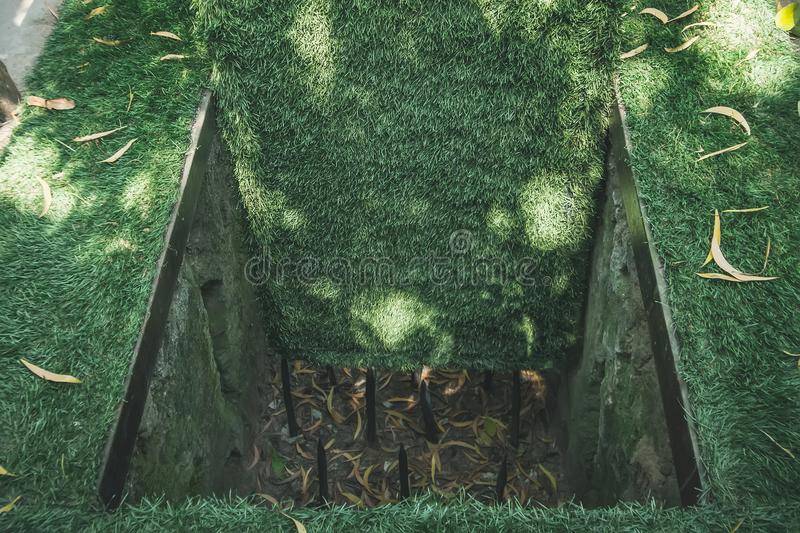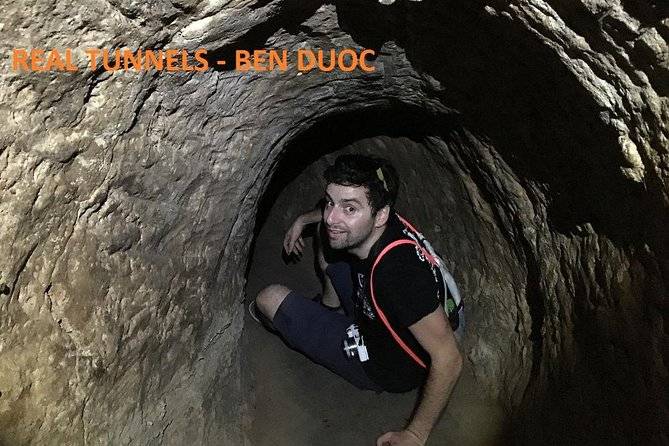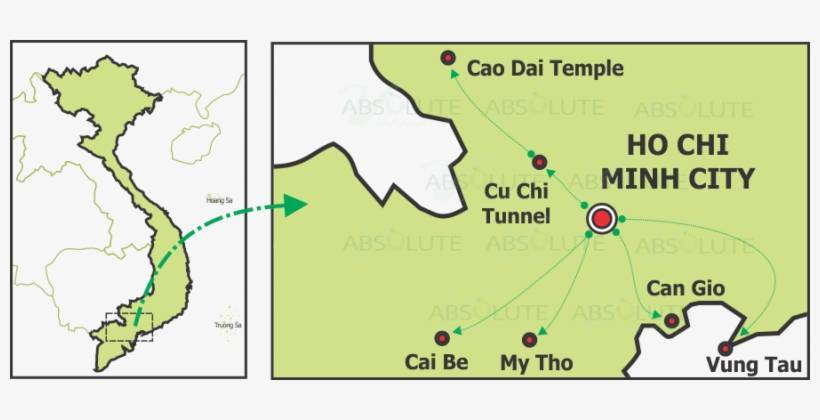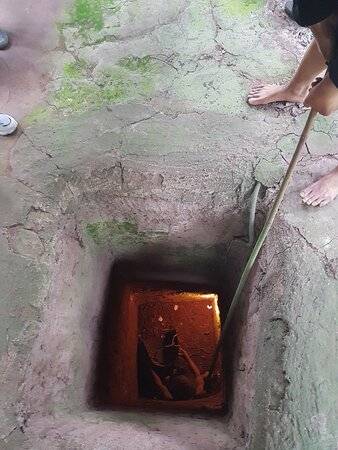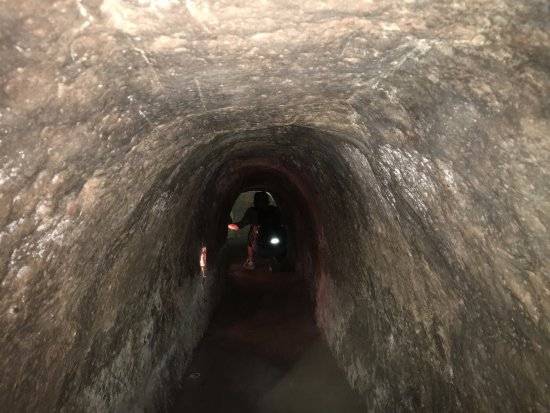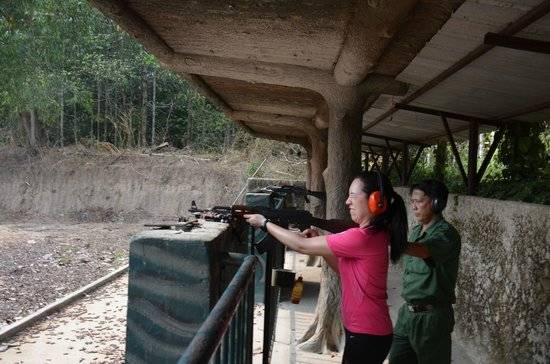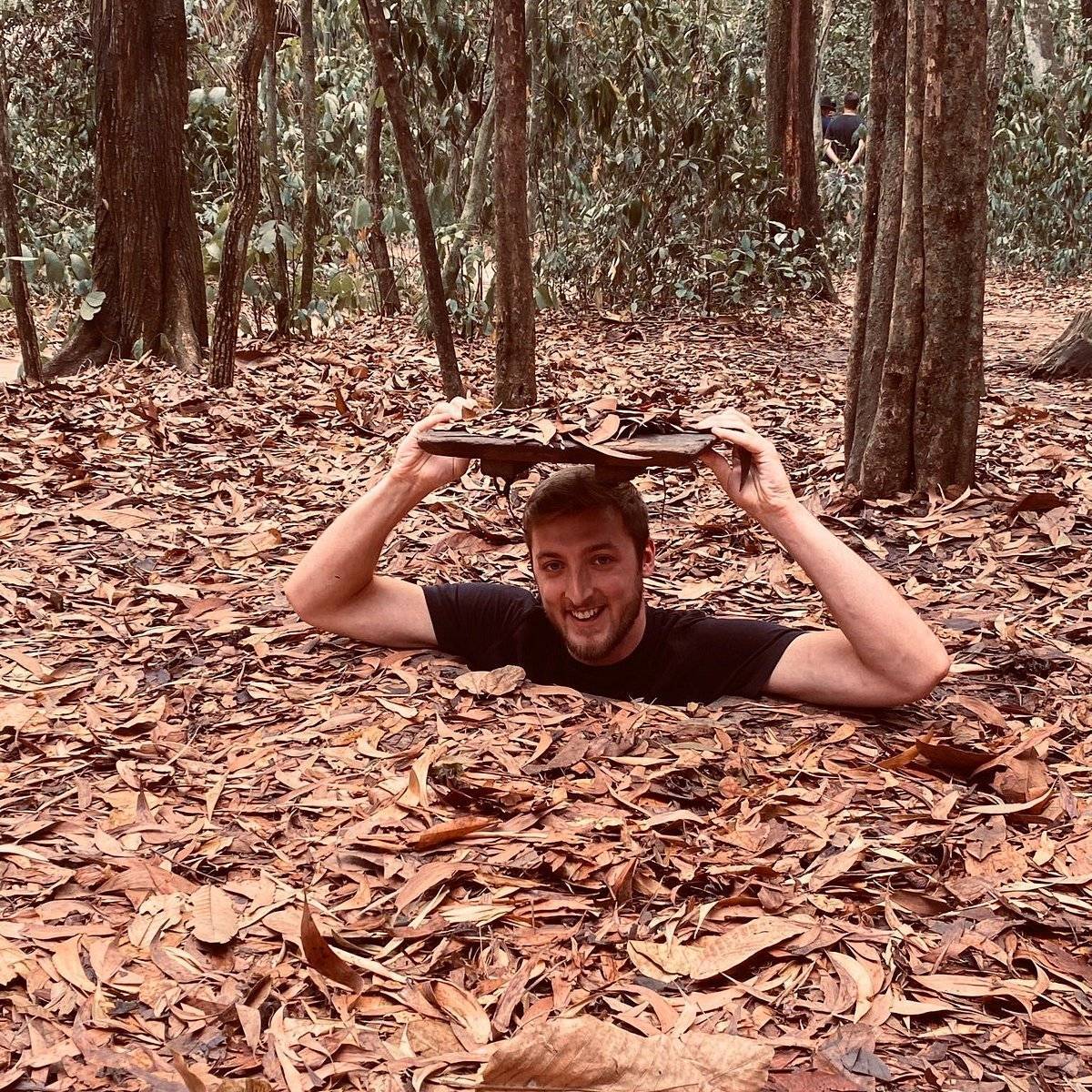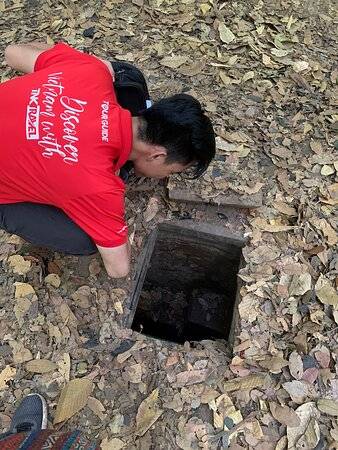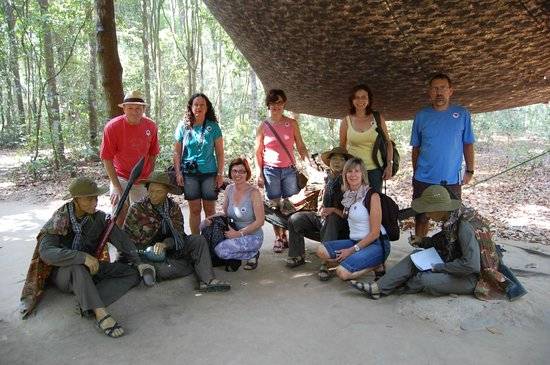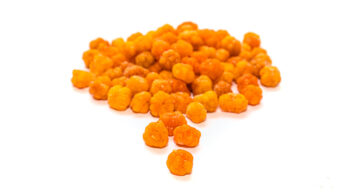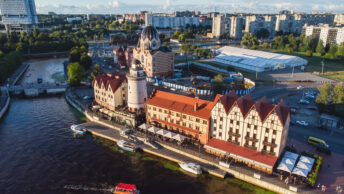How to get to Cu Chi Tunnels from Ho Chi Minh City
With public transport slow and erratic, day-trips are best arranged through a tour operator.
Tours
Travelling by bus
By far the easiest way of reaching the Cu Chi tunnel complex and the Cao Dai temple is to take a guided bus tour with one of the innumerable travel agencies operating around the Pham Ngu Lao area. In fact, it’s often possible to book such a trip without leaving the comfort of your accommodation – most guesthouses team up with a particular agency, and though they’ll want their own piece of the pie, the extra fee is usually small if it exists at all. Hotels are a different matter; many run their own tours, and the prices are usually a fair bit higher than those given here. In general, signing up through your accommodation will give you some kind of come-back should things go wrong. Most agencies charge in the region of 130,000đ per person for a half-day trip to the tunnels, and 180,000đ for a full-day sojourn to the tunnels and temple. This will include an English-speaking guide and admission fees to the tunnels, though it’ll cost extra for lunch. Tours usually leave at 8am, with half-dayers returning at 3pm or so, and full-day trips finishing around 6pm.
By taxi
Some people prefer to go by taxi, which will set you back around $70 including the main tunnels, the temple and waiting time.
By bus
A few budget travellers try to hit the temple or tunnels by bus, though it’s usually not worth the bother as some tours are so cheap that you’d end up saving hardly anything at all. If you’d rather go it alone, take one of the infrequent buses to Tay Ninh, which depart from HCMC’s An Suong station, north of the airport; ask the driver to drop you off at the front gates of the temple.
Where To Stay in Ho Chi Minh City
During our time in Ho Chi Minh City, we stayed in two different properties both located centrally in District 1. If you stay in District 1 you are within walking distance to the major sites in Ho Chi Minh City.
The 5-star luxury Pullman Saigon Centre Hotel is located at 148 Đường Trần Hưng Đạo, Phường Nguyễn Cư Trinh, Quận 1, Hồ Chí Minh 070000, Vietnam.
The hotel offers luxury accommodation in the heart of District 1 with a swimming pool, gym, good WiFi and their Urbane Lounge and the Mad Cow Wine and Grill that offers excellent views over the city. The hotel is in walking distance to Bui Vien Street, nicknamed ‘Backpackers Street” which is full of bars and restaurants. It is perfect for families, couples and solo travellers. Breakfast is included.
We also stayed at the 4 star A25 Boutique Hotel located at 55/29 Lê Thị Hồng Gấm, Phường Nguyễn Thái Bình, Quận 1, Hồ Chí Minh, Vietnam. The hotel is located in District 1 and offers comfortable accommodation, with a rooftop swimming pool with views, gym, good WiFi and breakfast is included. It is a popular mid-range hotel and we would recommend booking in advance.
NB
The Get Your Guide Tour will collect you from hotels in District 1.
Ho Chi Minh City Museum
 Ho Chi Minh City Museum
Ho Chi Minh City Museum
Near the Reunification Palace, the Ho Chi Minh City Museum occupies an impressive Neoclassical building, formerly known as Gia Long Palace, that was once home to the Cochinchina’s governor. It’s worth a stop for an overview of the city’s history and a look at the grand architecture, which includes Oriental and European flourishes.
The museum traces the city’s past with exhibits on the struggle for independence, nature and archaeology, trade, village handicrafts, currency, and the culture of Saigon. Interestingly, the building sits on a network of tunnels and bunkers, which served as escape routes for past dignitaries, though these are closed to the public.
Address: 65 Ly Tu Trong, District 1, Ho Chi Minh City
Official site: http://www.hcmc-museum.edu.vn/en-us/home-page.aspx
Other activities to do in Cu Chi Tunnels
1. Using sport guns or paintball shooting: This acts like a sport of military feature is to give you the exciting moments, which support you to know more about the military life.
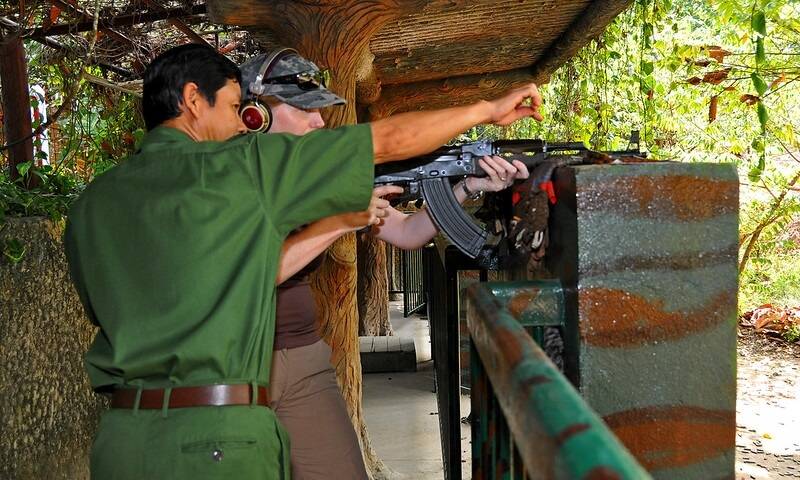 shooting at the Cu Chi Tunnels – Photo: Dennis Jarvis/flickr
shooting at the Cu Chi Tunnels – Photo: Dennis Jarvis/flickr
2. Swimming in the pool: Visitors can release the heat when swimming in the pool with an area of 150 m2 for children and 500 m2 for adults. After hours of visiting the sightseeing, you can take a dip in the clear blue water of the pool to enjoy the fresh and airy space.
3. Using kayaking: Tourists can use kayaks to travel on the like to enjoy nature, which is built like the shape of the East Sea.
4. Canoeing and cycling on water: you can join in thrilling games with fast canoes. Especially, cycling on the water is a new and exciting game that you can experience. That is funny.
5. Going camping: Your families can spend time together with camping on the banks of the Saigon River. The camping area is airy that is suitable for organizing outdoor activities.
>>> You may want to see the beaches near Ho Chi Minh City.
Shopping
Look at these flashy dresses I don’t need!
Neither of these 2 cities have the spectacular impact of shopping experiences found elsewhere in Asia – looking at you Bangkok. But if you’re looking for bargains, you can’t go wrong in Hanoi and Ho Chi Minh City.
In Hanoi’s Old Quarter the streets are still named according to pre-colonial times. Each one of them is specialized in a certain type of products like shoes, silk and silver items. Souvenirs, textiles and other unique handmade items are also common.
In Ho Chi Minh City you can haggle pretty much anything in the world-famous Ben Thanh Market. Higher-end shops and modern shopping malls like Takashimaya Vietnam and Vincom Center complete a rather more comprehensive and varied shopping scene. Superior shopping in clothing and electronics.
This really depends on what you’re looking to shop. It’s a really close call but Hanoi is more authentic. 5-5!
Ben Thanh Market & Saigon Square
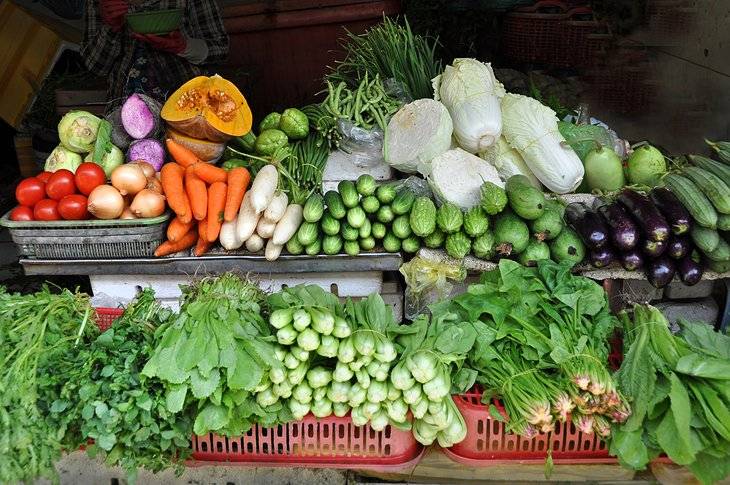 Ben Thanh Market
Ben Thanh Market
For sightseers, the hot and hectic Ben Thanh Market is almost an obligatory stop, even if only to witness the crammed stalls and market chaos. The stalls are piled high with everything from local delicacies, fish, flowers, and tropical fruits to shoes, clothes, colorful candy, and souvenirs. The markets are also notorious for pickpockets, so make sure any valuables are secure and out of sight.
After soaking up all the ambiance, head to Saigon Square, about a three-minute stroll away, for a slightly less frenetic shopping experience with the added bonus of air conditioning. Here, you’ll find fantastic deals on everything from clothing and backpacks to jewelry and shoes. Haggling is customary at both locations.
Address: 32-30, 36-34-32-30 Phan Boi Châu, Ben Thành, Ho Chí Minh City
How to get to Cu Chi Tunnels, Ho Chi Minh City
- By taxi: A taxi is a convenient yet the most expensive option as you can reach the tunnels within 1.5 hours.
- By bus: A bus is the cheapest but most time-consuming option which takes you 2.5 hours and roughly 25.000 VND to get to Cu Chi Tunnels’ area.
First, you catch bus No. 13 (from 23-9 Park / Ben Thanh Bus Station) or No. 94 (from Cho Lon / 12 Xuan Dieu) to Cu Chi Bus Station, then get on bus No. 79 to Ben Duoc Tunnel or bus No. 63 to Ben Dinh Tunnel.
- By private motorbike/car: You can rent a motorbike or car in Ho Chi Minh City at affordable prices and follow Northwest of National Road 15 to get to the site. Remember to turn on GPS and check the weather before your trip since the route to Cu Chi district can be difficult for first-time travelers.
- By boat/ canoe: A boat or canoe will provide a new experience for your Cu Chi Tunnels travel. You can take a speedboat (with the first boat leaving at 7:30 am every day) departing from Tan Cang pier along the Saigon River to Cu Chi in 75 minutes.
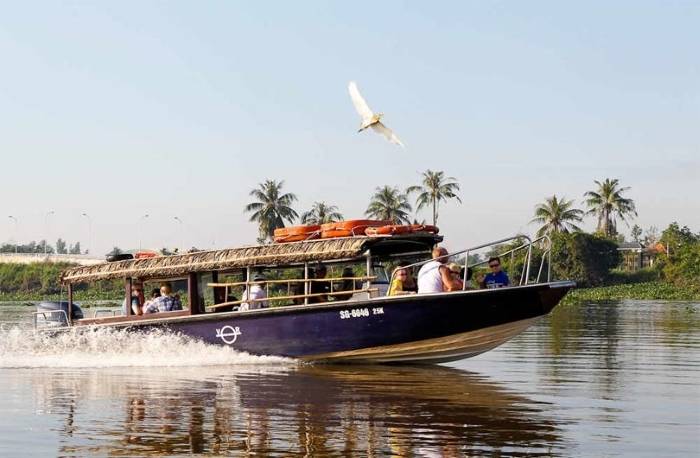
>>> Book a hotel room in Ho Chi Minh City before delving into the underground world of the astonishing Cu Chi tunnels
Private Ho Chi Minh Tours
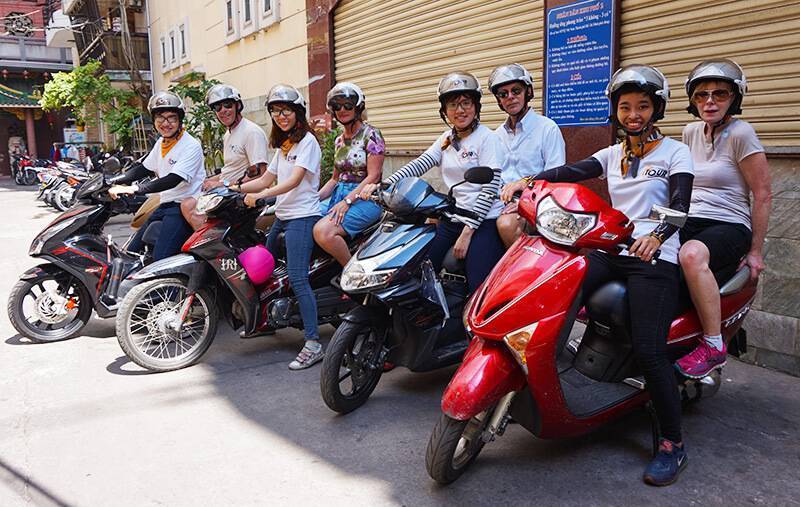
All tours are private, customizable, and led by professional English-speaking guides. For more reference, read our customer reviews or see below for the tour package in Ho Chi Minh that works for you.
Vietnam Travel Information
Check out the necessary information for traveling to Vietnam
Vietnam Travel Adaptors
Major Cities in Vietnam
Family & Elderly Travel
LGBT Travel
Vietnam Festivals and Holidays
Best Vietnamese Dishes
UNESCO World Heritage in Vietnam
Responsible Travel in Vietnam
Vietnamese Culture
Religions in Vietnam
Ethnicities in Vietnam
Tipping in Vietnam
Vietnamese Currency Guide
Best Dishes to Try in Vietnam
20 Must-try Vietnamese Dishes
Unusual Foods to Try in Vietnam
Street Food in Vietnam
Vietnamese Grilled Dishes
Rice Dishes in Vietnam
Pho Dishes in Vietnam
Holiday Dishes to Try during Tet Holiday
Chinese Dishes in Vietnam
Dishes to Try in Northern Vietnam
Dishes to Try in Central Vietnam
Dishes to Try in Southern Vietnam
What to Eat in Ho Chi Minh City
What to Eat in Hanoi
What to Eat in Hue
What to Eat in Hoi An
What to Eat in Da Lat
What to Eat in the Mekong Delta
Traveling to and within Vietnam
Airport Arrival Tips at Tan Son Nhat International Airport (Ho Chi Minh)
Airport Arrival Tips at Noi Bai International Airport (Hanoi)
Major Airports in Vietnam
Taking Trains in Vietnam
Bringing your Motorbikes on Trains in Vietnam
Bringing Your Own Vehicles to Vietnam
Bringing Your Pets to Vietnam
How to Take Motorbike Taxis
Taking a Ferry in Vietnam
Renting a Car in Vietnam
How to Travel from Hanoi to Da Nang
How to Travel from Hanoi to Hue
How to Travel from Hanoi to Sa Pa
How to Travel from Hanoi to Mai Chau
How to Travel from Hanoi to Moc Chau
How to Travel from Hanoi to Cao Bang
How to Travel from Hanoi to Mu Cang Chai
How to Travel from Hanoi to Ha Giang
How to Travel from Ho Chi Minh to Mui Ne
How to Travel from Ho Chi Minh to Da Lat
How to Travel from Ho Chi Minh to Phu Quoc Island
How to Travel from Da Nang to Hoi An
How to Travel from Hue to Phong Nha
Vietnam Travel Itineraries
Vietnam One-month Itinerary
Vietnam One-week Itinerary
Taking a Gap Year in Vietnam
Backpacking in Vietnam
Expat Tours in Vietnam
Honeymoon in Vietnam
Vietnam Visa, SIM Cards, and WiFi
Visa Info & Where to Buy Sim Cards
Traveling with Wifi in Vietnam
Vietnam Travel Safety Tips
Travel Insurance
Is it Safe to Drink Tap Water?
How to Avoid Mosquitoes
Food Safety in Vietnam
Getting Vaccinations
Common Diseases and How to Prevent
Wearing Face Masks in Vietnam
Can Tourists Drive in Vietnam?
How to Avoid Scams
Travel Safety Tips
Best Places to Stay in Vietnam
Deluxe Hotels in Vietnam
Best Hotels in Ho Chi Minh
Best Hotels in Hanoi
Where to Stay in Ha Long Bay
Where to Stay in Mai Chau
Where to Stay in Moc Chau
Where to Stay in Ha Giang
Where to Stay in Cao Bang
Where to Stay in Lang Son
Where to Stay in Sa Pa
Where to Stay in Mu Cang Chai
Where to Stay in Kon Tum
Where to Stay in Da Lat
Where to Stay in Mui Ne
Where to Stay in Hoi An
Homestays in Vietnam
Find more hotels to stay in Vietnam below:
SAIGON/ HO CHI MINH AIRPORT TO HO CHI MINH CITY
BY GRAB
The most convenient way to get from Ho Chi Minh Airport (Tan Son Nhat Airport) to Ho Chi Minh City is by Grab, it’ll cost around VND 89,000 (PHP 197 / USD 4 / SGD 5) to get to Phum Nga Lao Street (Backpacker Street) from Ho Chi Minh/Saigon Airport by Uber X. If you are alone and you only have one or two backpacks with you, you can opt for Grab motorbike, it’s cheaper, around VND 43,000 (PHP 95 / USD 2/ SGD 3). Toll fee is VND 10,000 (PHP 22 / USD 0.44/ SGD 0.61).
BY BUS
Cheapest way to downtown Ho Chi Minh is by Bus #152. I used this before to get to Pham Ngu Lao Street (Backpacker Street) in Ho Chi Minh. Fare is roughly VND 5,000 (PHP 11 / USD/ SGD 0.30) and additional VND 5,000 per bag. But it only runs until around 6:00 PM
You may also take the Bus #109 (Airport Bus) for VND 20,000 (PHP 44/ USD 2/ SGD 1.21) that runs from 5:30 AM to 1:30 AM.
II. Historical highlights of Cu Chi Tunnels
The militiaman of Tan Vu Trung and Phuoc Vi An Hamlet began digging these underneath tunnels in the early 1940s. In its original form, Cu Chi Tunnels comprised some simple, fragmental tunnels and vaults which were mainly used for sheltering, hiding confidential documents and weapons.
Read more: War Museum Ho Chi Minh, Vietnam – Everything You Need To Know
Afterward, due to the need for communication amongst hamlets, the underneath tunnels were adjoined to create a complicated system. Then, this system was continued to expand to surrounding areas including six hamlets in the North of Cu Chi District. The quality of the tunnels was also improved to become suitable for combating these guerrilla tactics, communicating and supporting amongst Vietnam South Forces.
From 1961 to 1965, the network of the hamlets in the North Cu Chi was chosen to be the “backbone” of the battle connecting all strategic points. On the ground, the militiaman of Cu Chi District also set up the plexus of communication trench perimeter. In addition, above ground were a system of the barricade, minefields, nail pits, and spike-traps, which formed a solid and invincible battlefield.
At the end of 1965, there were approximately 200 kilometers of tunnels completed and put into operation. At that time, Cu Chi Tunnels consisted of 3 floors of different depth. The top one was 3 meters under the grounds. The second one was 6 meters and the bottom was 12 meters under the ground. Back in those days, these tunnels were also a place for living, aiding, holding meetings, and storing weapons.
At the event of Tet Offensive (1968), it’s the Cu Chi Tunnels that were used by the National Front for the Liberation of South Vietnam to carry out the full-scale attack to Saigon. Despite suffering continuously severe bomb rain of the enemy, the tunnels still remained steadily.
In 2015, Cu Chi Tunnels were recognized as “Hero of Labour”, one of the noblest titles of the Socialist Republic of Vietnam. On 12th February 2016 Cu Chi Tunnels was officially designated the Special National Monument. Every year, Cu Chi Tunnels attract nearly 2 millions of visitors all over the world
The map of Cu Chi Tunnels
Cu Chi Tunnels have located about 60 km from the Northwest from the center of Ho Chi Minh City. This is a miniature place of the battle of the army and people of Cu Chi in the resistance war for 30 years to bring independence and freedom for the country.
The location map to Cu Chi Tunnels from Ho Chi Minh City:
At present, the tourist area consists of 2 parts with 13km apart:
- Ben Duoc Tunnels are situated in Phu Hiep Hamlet, Phu My Hung Commune, Cu Chi District, and
- Ben Binh Tunnels are in Nhuan Duc Commune, Cu Chi District.
You can go to Cu Chi Tunnels from Ho Chi Minh in many ways. If you take the bus, just take the number of 13 to Cu Chi bus station and continue to catch another one of 79, you will reach the tunnel. And, if you want to use a private car to visit the tunnels, you tell the driver to drive you to Ben Dinh or Ben Duoc Tunnels. And, he can know the best way to come to that place easily.
The structure map inside Cu Chi Tunnels:
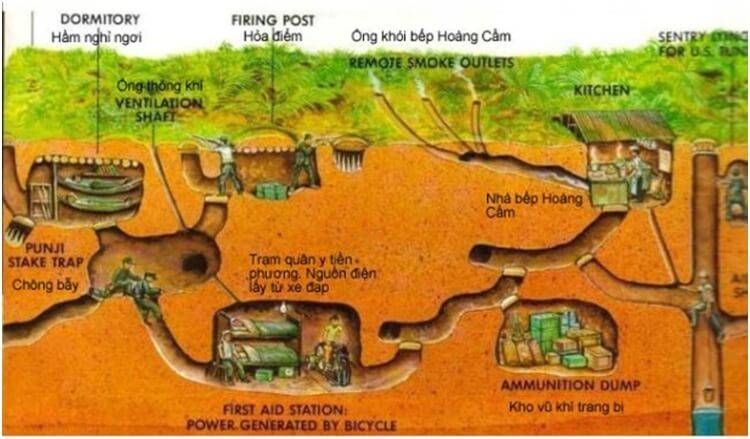 Inside structure of Cu Chi Tunnels – Photo: internet
Inside structure of Cu Chi Tunnels – Photo: internet
Eat Amazing Vietnamese Food
Vietnam is renowned for its cuisine. A delicious combination of European and Asian cuisine, thanks to French colonization and influences from its neighbouring countries.
This makes Vietnam a great destination for foodies, and Ho Chi Minh City is no exception. You will find all popular Vietnamese dishes here, including must-tries such as pho, banh mi and banh xeo.
For 15-25,000 VND you can pick up a banh mi from some of the best spots in the city. This is a sandwich of pate, meat, and vegetables inside a freshly baked baguette. Banh Mi Huynh Hoa in District 1 is hard to beat for the price, but you can find a good banh mi almost anywhere – even the ones from Circle K aren’t too bad.
Make sure you venture out from the most popular dishes and basically try anything you can get your hands on. Bun Cha is a delicious dish that shouldn’t be missed. Our favourite place for bun cha in Vietnam is Bun Cha 145 which can be found on the walking street. District 1 is home to many great restaurants.
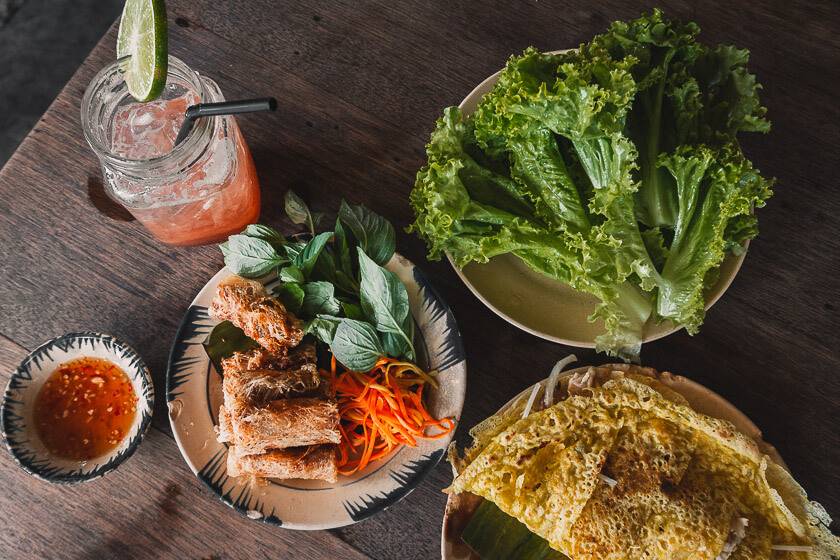
Follow us on Instagram!
25 Best Things To Do In Ho Chi Minh City (Vietnam):
- Try a bowl of pho
- Visit the Giac Lam Pagoda
- Tour the War Remnants Museum
- Take a Bonsai River Cruise
- Visit the Central Office
- Tour Reunification Palace
- Have a drink in Pham Ngu Lao Street
- Grab a coffee in Tao Dan Park
- Tour the History Museum
- Take a cooking class
- Visit Notre Dame Cathedral
- Travel to the Mekong Delta
- Crawl through the Cu Chi Tunnels
- Admire the Cao Dai Temple
- Have breakfast at Binh Tay Market
- Scale the Bitexco Financial Tower
- Eat at Banh Xeo 46A
- Admire the Phoc An Hoi Quan Pagoda
- Tour the Ho Chi Minh City Museum
- Browse in Ben Thanh Market
- Visit the Jade Emperor Pagoda
- Grab a sandwich at Banh Mi Huynh Hao
- Admire Cha Tam Church
- Giac Vien Pagoda
- Explore the Fine Arts Museum
Ho Chi Minh City Itinerary Travel Guide
Now that you know what to do with 3 days in Saigon, here’s my travel guide to help you plan the rest of your trip here.
When to Visit Ho Chi Minh City
Whenever you come to Ho Chi Minh City, you can expect to sweat a lot. It’s always hot here – it’s just a matter of whether it’s dry or wet.
Generally speaking, the best time to visit HCMC is between December and March. This is the dry season, so you won’t have to worry about getting drenched while sightseeing.
One thing to keep in mind is the timing of Tet. The Vietnamese New Year follows the lunar calendar as it does in China.
This is a crazy busy time of year when the whole country is travelling to visit family.
Getting Around Ho Chi Minh City
There’s no doubt that the chaotic traffic of HCMC is a bit intense. As such, getting around the city is a bit tricky.
Unfortunately, there’s no metro system here, so you’ll likely get around by a combination of taxis, walking, and perhaps the occasional xe om (mototaxi) or cyclo (rickshaw) ride.
You can use rideshare apps like Grab here, but I’m pretty sure Uber isn’t operating here anymore. You’ll need your phone to be working for this, so pick up a local SIM card.
If you’re an experienced rider, you can rent a motorbike for your stay. This definitely isn’t the place to learn, though!
There’s also a vast network of local buses, but these can be tricky to figure out if you don’t speak or read Vietnamese. It’s definitely an adventure trying to get around the city on the bus!
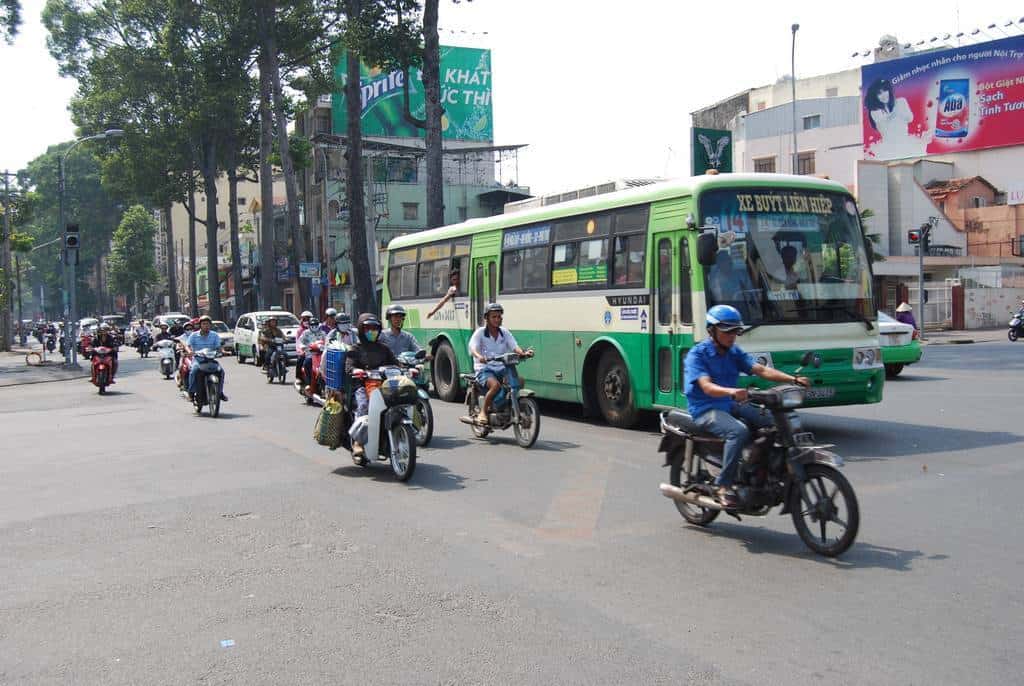 Have fun crossing the street!
Have fun crossing the street!
Where to Stay in Ho Chi Minh City
Here’s my personal recommendation on where to stay in Ho Chi Minh City, depending on your budget.
Best Budget Accommodation – Da Blend Hostel
Our top choice for budget accommodation in HCMC goes to Da Blend Hostel. It’s located just outside of the touristy area in a more local neighbourhood. They have free breakfast and cool events like family dinners or board game nights.
Best Mid-Range Accommodation – Rex Hotel
A great choice in the mid-range category is the Rex Hotel. This famous hotel is located right in the heart of the city and is full of amenities. There’s a rooftop garden, two outdoor pools, a spa, and more.
Best Luxury Accommodation – Grand Hotel Saigon
Those looking for a bit of luxury can check-in to the Grand Hotel Saigon. This 5-star hotel retains its French colonial style and offers plenty of modern amenities. It’s located near the river, which you can admire from their rooftop lounge.
Best Restaurants in Ho Chi Minh City
Pho 24 – Ubiquitous chain cooking up the famous Vietnamese soup.
Ben Thanh Market – This huge market is a must-visit, especially for all the tasty local food!
Noir. Dining in the Dark – A very unique experience where you dine in the dark and are served by blind or visually impaired people.
Bahn Mi Bistro – There are a few locations in the city making gourmet versions of the Vietnamese sandwich.
Shamballa – A very popular vegetarian restaurant and tea house.
Bun Bo Nam Bo Ba Ba – Try saying that name 3 times fast! This place cooks up classic Vietnamese street food just like ba (grandma) used to make.
Ngon Villa Saigon – Come hungry to try the marathon degustation menu at this highly-rated Vietnamese restaurant.
Secret Garden – Enjoy home-cooked local food in a beautiful setting that really is a secret garden.
Bun Cha 145 – While this dish hails from Hanoi, you can enjoy a delicious bowl of it right here on the backpacker street of HCMC.
DISCLAIMER: Some of the links in this article are affiliate links, which means if you book accommodation, tours or buy a product, we will receive a small commission at no extra cost to you. These commissions help us keep creating more free travel content to help people plan their holidays and adventures. We only recommend the best accommodations, tours and products, and regularly review these. Thanks for your support, kind friend!
Thiên Hau Temple, Chinatown
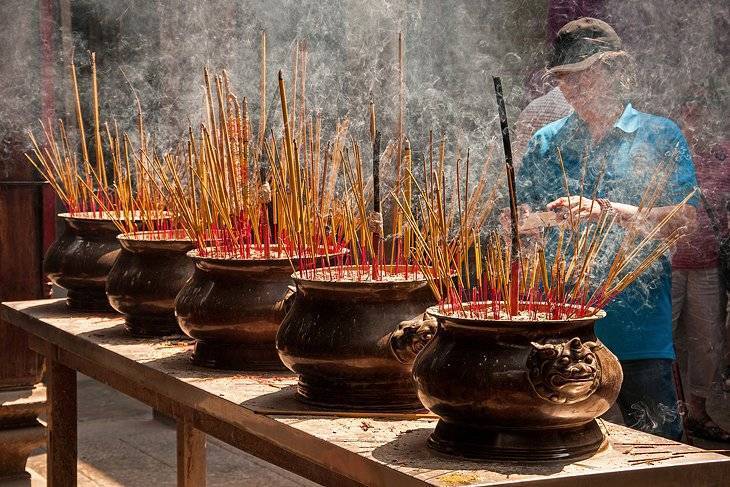 Thiên Hau Temple, Chinatown | bvi4092 / photo modified
Thiên Hau Temple, Chinatown | bvi4092 / photo modified
The atmospheric 19th-century Thiên Hau Temple is one of the best places to visit in Ho Chi Minh City’s Chinatown (ChoLon) and one of the oldest Chinese temples in the city. Dedicated to the Lady of the Sea, Thiên Hau, this evocative temple is visited by local worshippers, as well as tourists, and many of the materials used in its construction were brought from China.
Clouds of incense billow in the air, candles flicker on altars, and shafts of sunlight pierce through the partial roof as you enter the green wrought-iron gates and stroll across the small courtyard. From here, you can see the altar, with statues of the goddess, and the intricate porcelain dioramas adorning the roof depicting scenes from 19th-century Chinese life.
According to legend, the goddess left two turtles to guard the temple in her absence. On the 23rd day of the third lunar month, a parade takes place in the neighborhood featuring a figure of Thiên Hau, who is believed to save seafarers stranded on the high seas. Entry to the temple is free.
While you’re visiting China Town, it’s also worth stopping by the hectic Binh Tay Market, which sells everything from fresh produce to Chinese trinkets. The area is also home to some beautiful examples of classical Chinese architecture.
Address: 710 Nguyen Trai Street, District 5, Ho Chi Minh City
1) History of the Cu Chi Tunnels
Here is a quick history lesson if you are interested in learning why these tunnels are there in the first place. These tunnels were part of a vast underground network built by the Viet Cong during the war in order to gain an upper hand against the troops in the south. They used them as a way to surprise attack their opposition and would sleep, eat and live their lives underground.
For the Viet Cong, it was more than just some tunnels – they were more like underground cities. Not only would they sleep down there, but there were hospitals, weapon factories and even theaters built underground.
These tunnels were the best way for the Viet Cong to avoid the aerial bombings and gave them the chance to fight off south Vietnamese and the American troops.
Today just a portion of this vast underground tunnel network is open for tourists to get a glimpse of what the tunnels were like.
How to Get to Cu Chi Tunnels
There are many ways to get to Cu Chi Tunnels, you can choose one of the below means of transportation.
1. By Bus
A bus is the cheapest way to go to Cu Chi. First, you catch bus No 13 from 23-9 Park (near Pham Ngu Lao street) to Cu Chi Bus Station, then change to bus No 79 which heads to Ben Duoc. It will take you 2 and a half hours and more than USD 1 if going by bus.
2. By Taxi
Taxi is the most convenient but also the most expensive one. For 140 km to Cu Chi, you may have to pay USD 60. You can book a taxi online with Grab application or on any streets.
3. By Motorbike/car
You can use your own motorbike or car, or rent one in Ho Chi Minh City. The traveling distance is 140 km, so it is possible to go by personal motorbike or car. It only takes 1 and a half hours to go from the center of Ho Chi Minh City to Ben Dinh section.
4. By Boat
A speedboat will take you from Tan Cang pier through Saigon River to Cu Chi in 1 and a half hours. It’s better to take the morning boat at 7:30 am every day.
Tour the War Remnants Museum
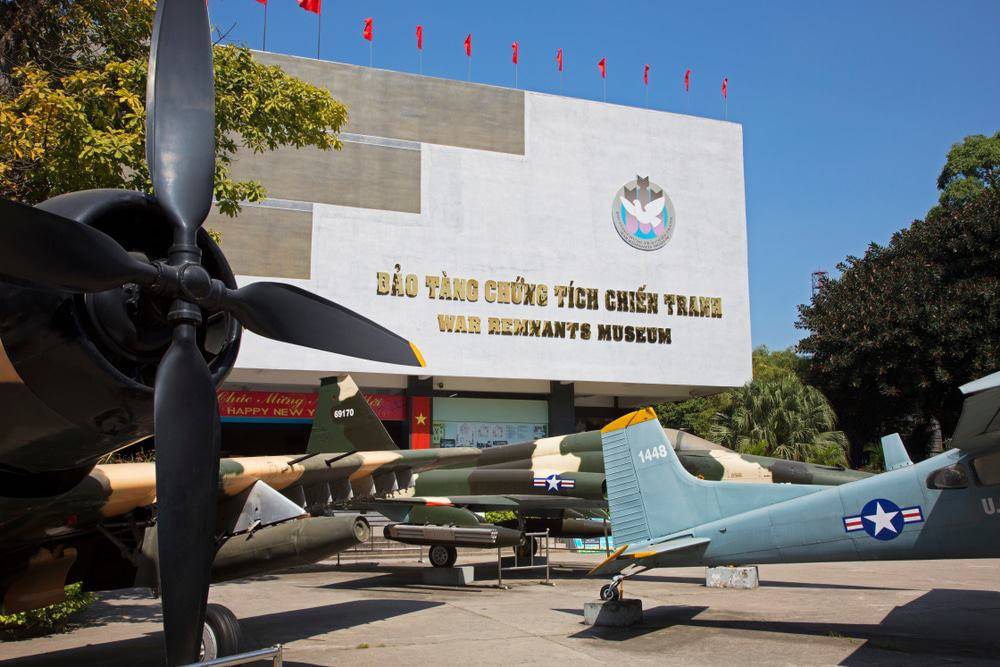 Source: DnDavis / shutterstockWar Remnants Museum
Source: DnDavis / shutterstockWar Remnants Museum
The War Remnants Museum is one of the most moving sights in Ho Chi Minh City and is dedicated to educating visitors about the atrocities of the Vietnam War.
This is one of the most popular museums in all of Vietnam and more than half a million visitors come here every year.
Some of the items on display include old military vehicles like Huey helicopters as well as attack bombers and M48 Patton tanks.
Inside you will also find personal memorabilia of victims of the war as well as old photographs.
Suggested tour: VIP City Highlights: War Remnants Museum & Ben Thanh Market
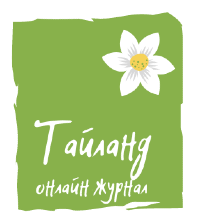

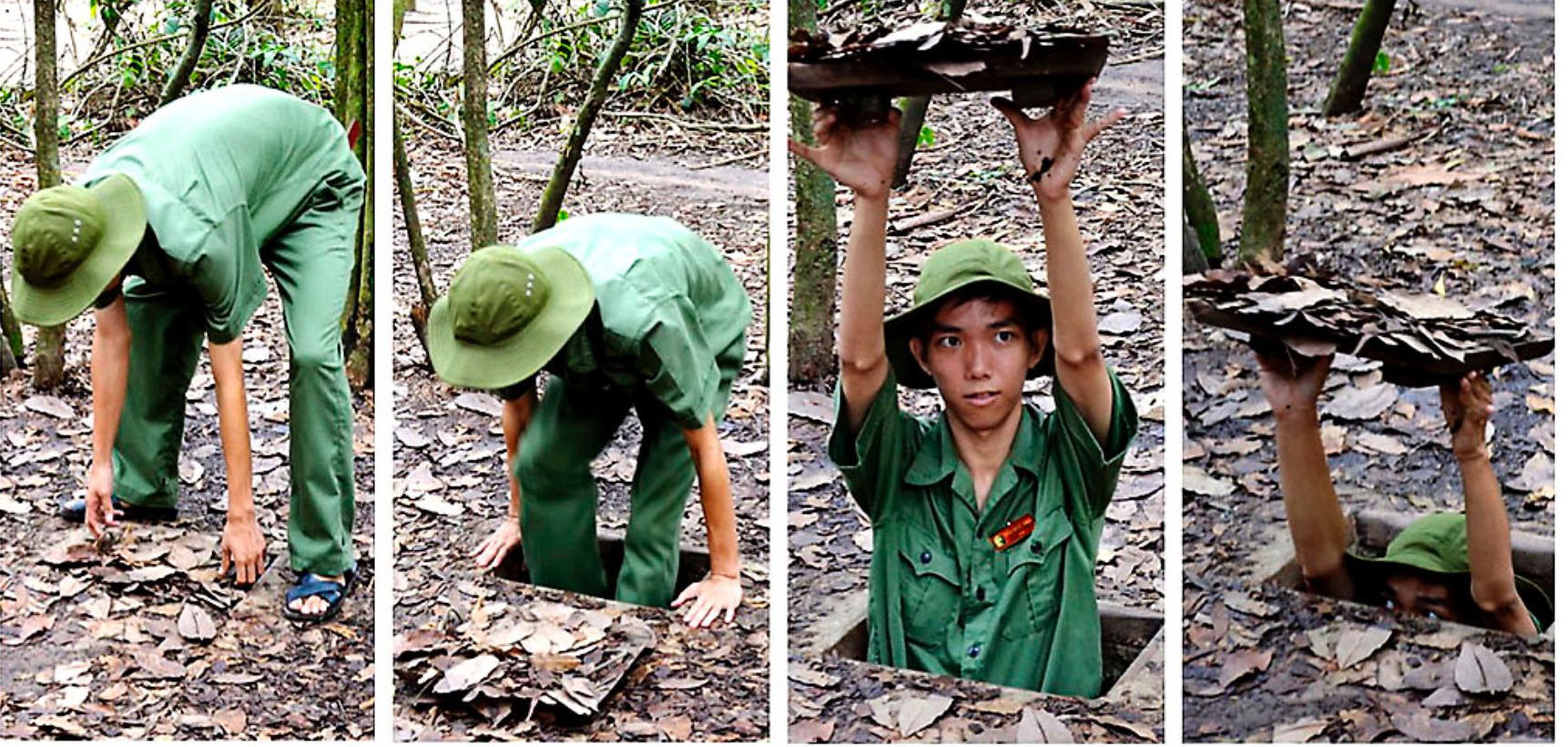

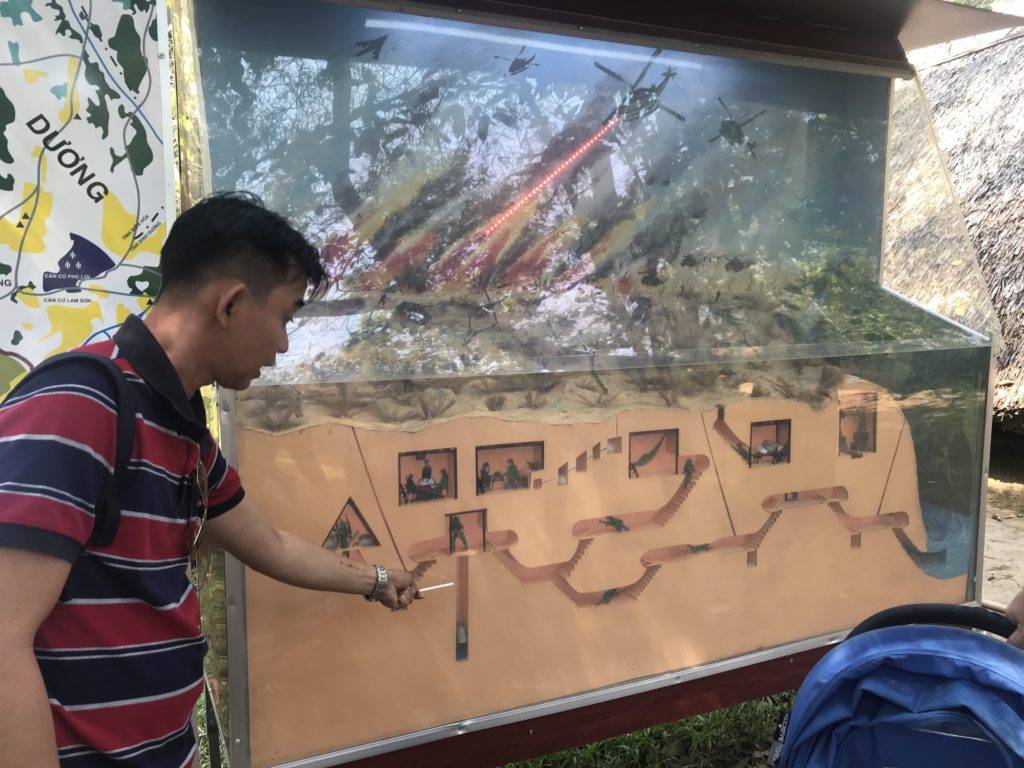
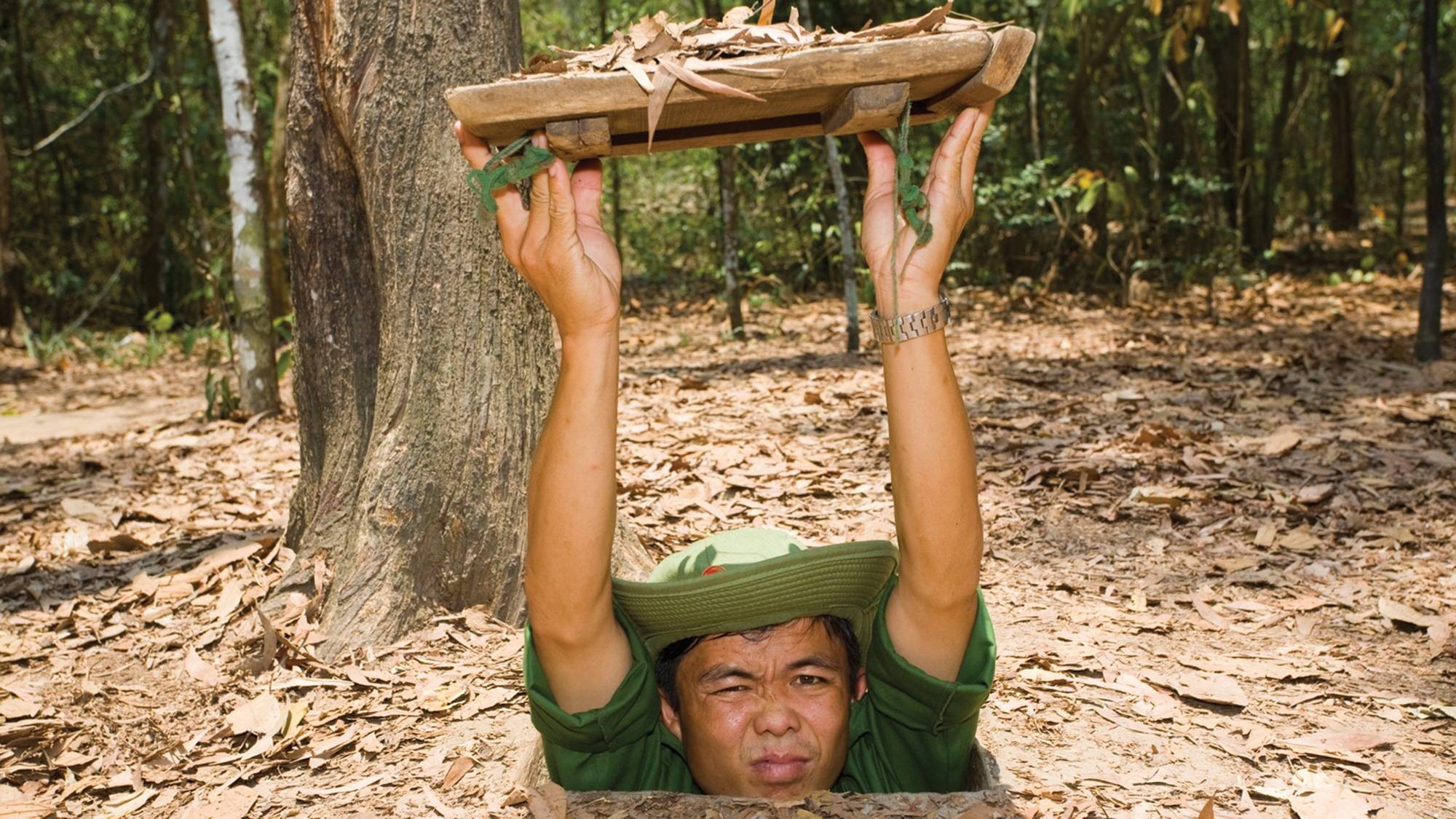
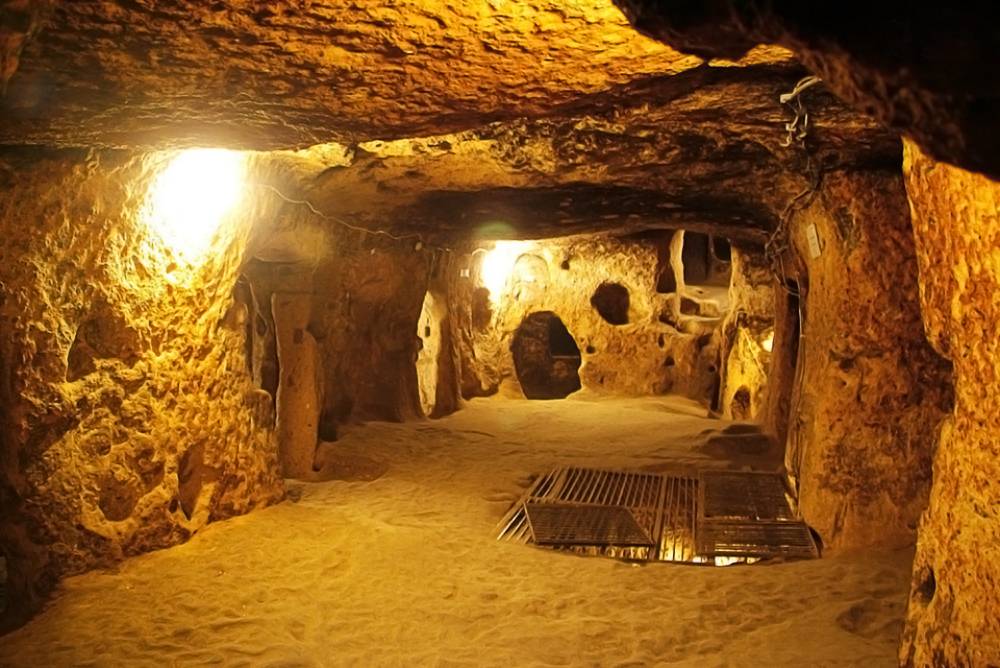
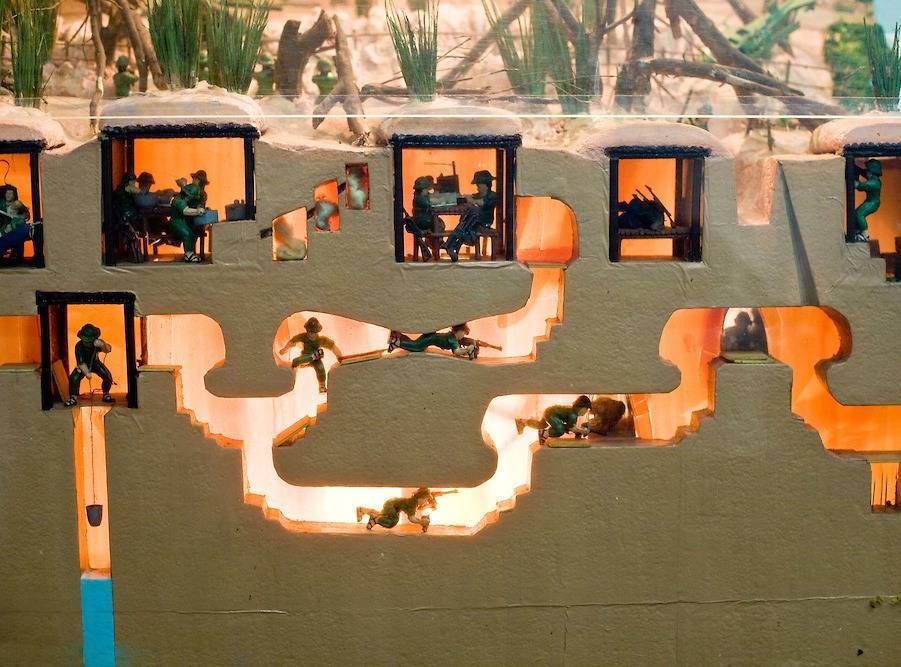
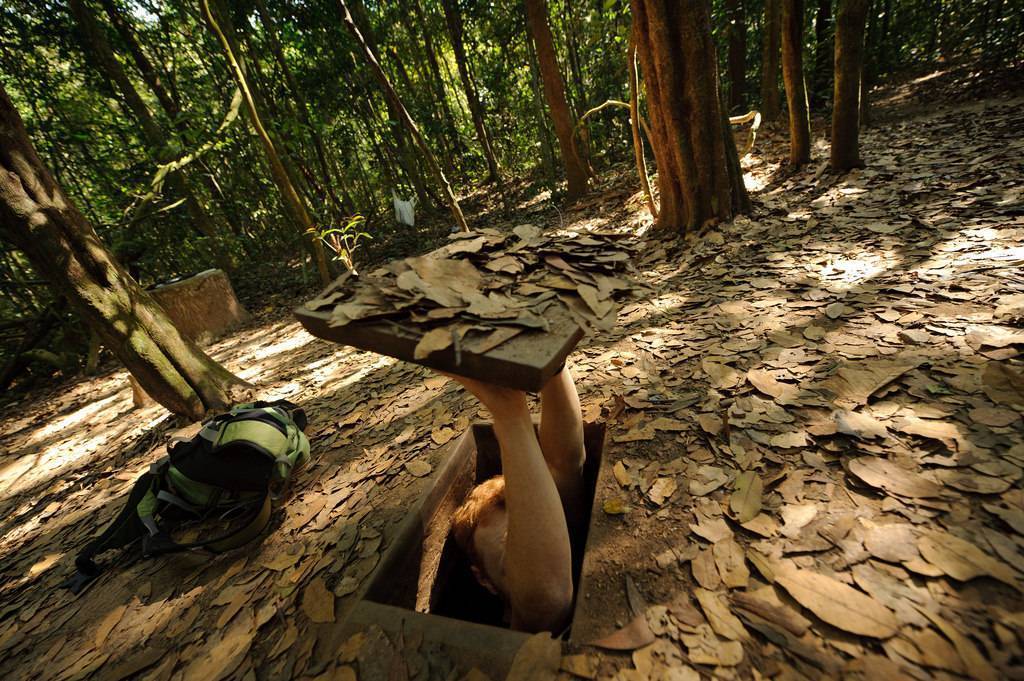
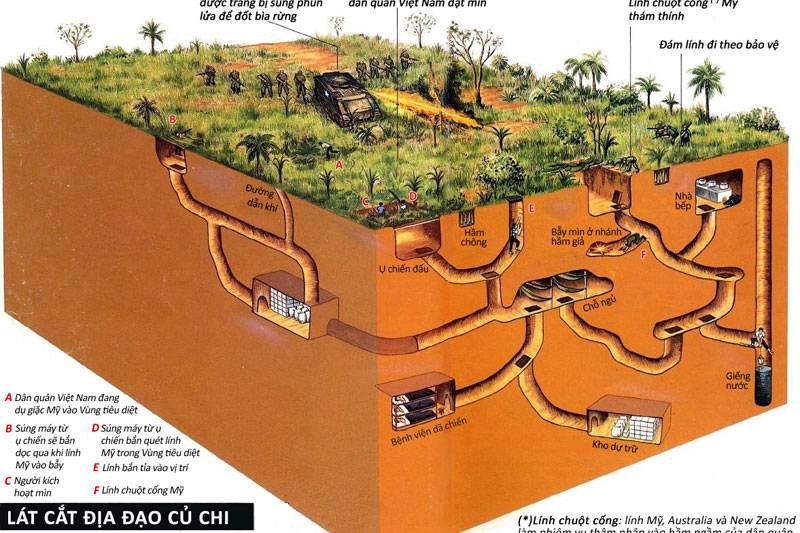
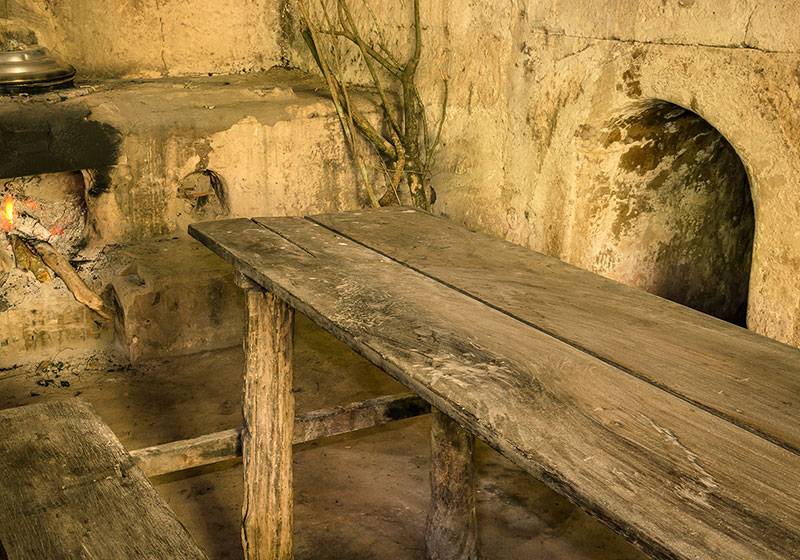

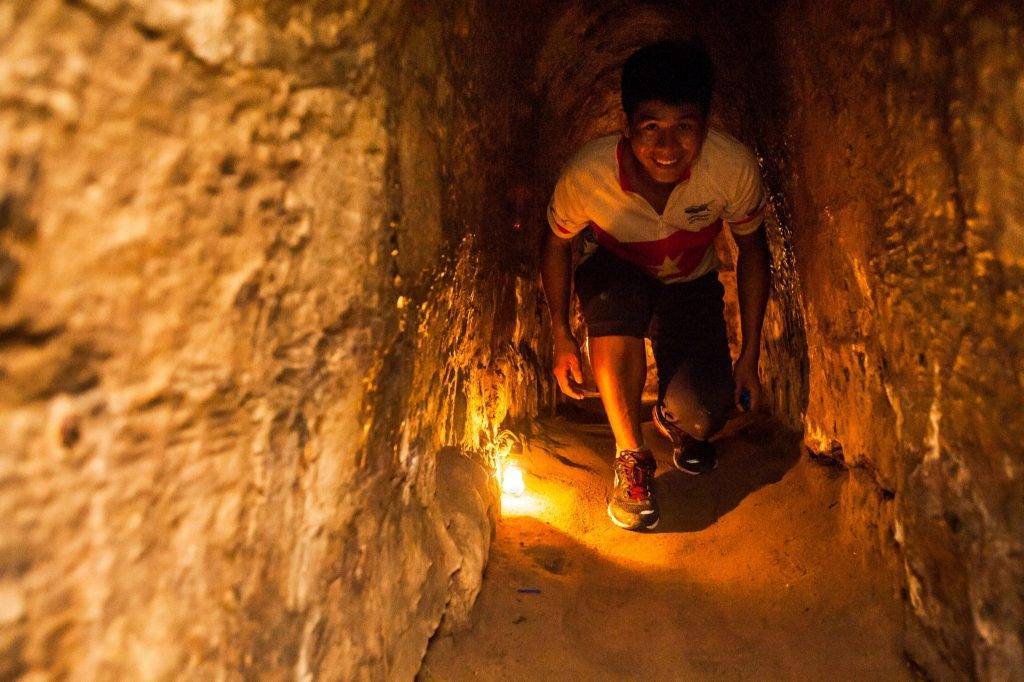
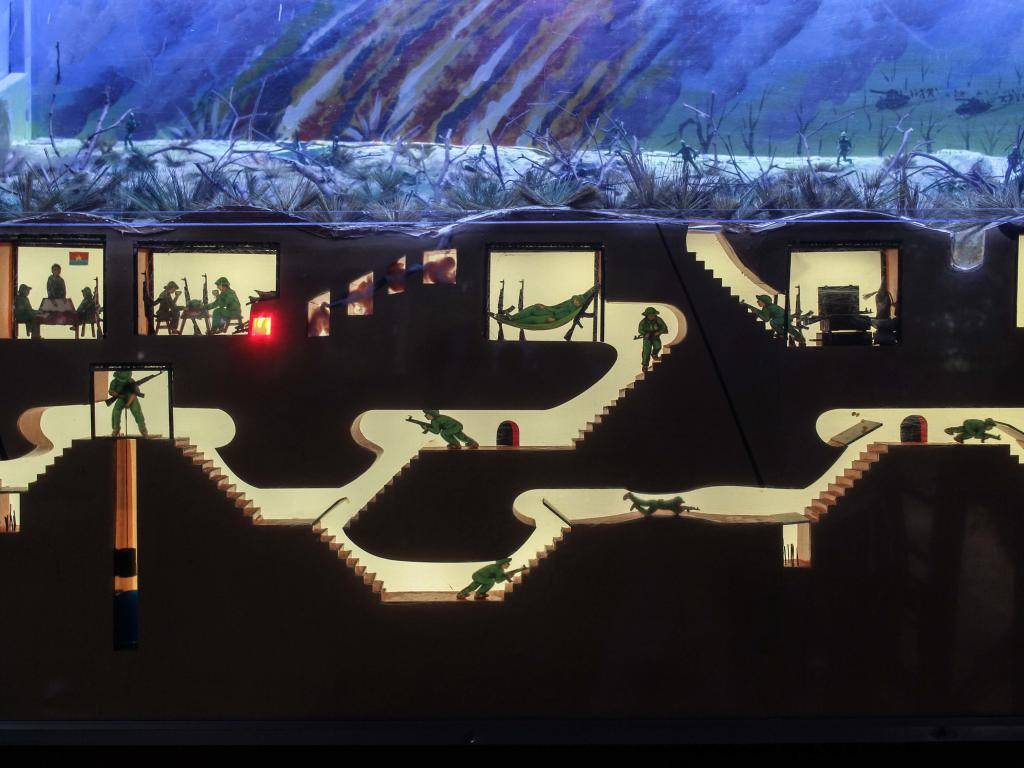
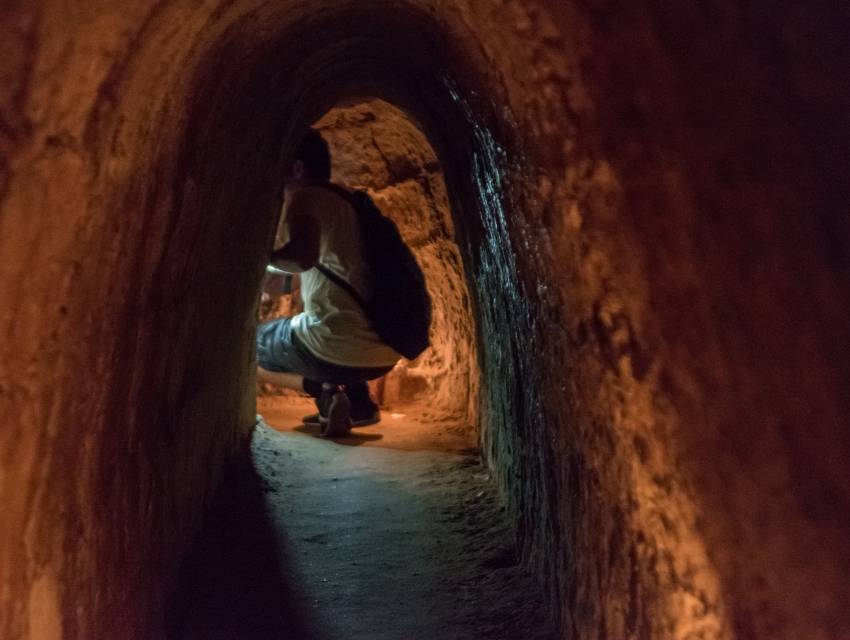
![The perfect 3 days in ho chi minh city itinerary [2022]](https://thailand-good.ru/wp-content/uploads/3/c/5/3c54d60ff5540edb20312c1ec17cbf61.jpeg)
